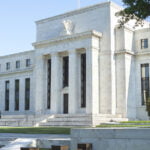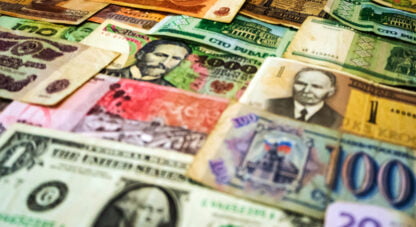Podcast: Play in new window
- Inflation IS The Policy Of The Fed
- Government Uses Inflation To Pay Down Its Debt
- You Are Buying The Government’s Debt Every Day
“Does the stock market being near all-time highs, does the crypto market cap—if you’re counting it in aggregate—in excess of $2.3 trillion, does that indicate tight financial conditions?
“No. Contrary to those positive and enthusiastic expressions of greed and expressions of speculation, what do we still have in the mix? This is where the Main Street investor is sometimes played as the patsy. We’ve got insider selling which continues at an aggressive pace. Tech insiders that haven’t sold shares in decades are moving chunks of 20 to $40 million at a time.
“The record plays and round and round we go, until the music stops.” —David McAlvany
Kevin: Welcome to the McAlvany Weekly Commentary. I’m Kevin Orrick, along with David McAlvany.
David, I was just talking to a client yesterday, just giving him an update on his IRA, and we were looking back a couple of years back to 2022. I said, “Hey, do you remember that swap we did?” We had American silver Eagles, and based on speculation and a lot of people buying, the premium on those coins jumped up enough that we were able to turn 1,360 ounces of silver eagles into about 2,000 ounces of silver in bars.
Now, of course, that’s come back down and that jump may happen again at some point, but this company has been around for 52 years, your family’s company. It’s amazing what you can do when you just pay attention to the rhythms, and take advantage of the premiums when they jump.
David: Being in business for 53 years, you do see market anomalies, things that would not be immediately obvious to someone who’s fresh to the markets. And so the decades do matter. The advice given does matter, and as you just described, it can be quite attractive in terms of an accumulation of ounces, free silver in that case, taking advantage of the premiums. And that’s something that, again, 53 years in the business. We were the first company to put gold into IRAs back in 1986, and created a variety of other tools like Vaulted to allow for savings in the form of ounces. And this is a time that I think paying attention to what’s happening in the gold market really does matter.
Kevin: So what would you say is happening in the gold market right now from your perspective, Dave?
David: Well, gold continues to consolidate sideways while there’s room for it to correct lower in price. The sideways consolidation works off its overbought condition, in preparation for another move higher.
Probably doesn’t surprise you to learn that we’re bullish on the metals.
Goldman Sachs is as well. Goldman has moved its year-end price target to $2,700 an ounce. That gold price projection puts $42 to $47 silver in a reasonable range for 2024. And margins, if you’re talking about the miners, margins for the metal producers will surprise at the end of Q2, and I think that’s going to be a critical leverage point. The Western investor will venture back into this space.
They’re very rarely early, but I don’t think they’ll miss this move. There’s still pockets of value in the metals space, but not for long.
Kevin: When you talk about margins, what are you talking about?
David: Yeah, well, margin expansion is the story in the miners’ category.
So let’s say, for instance, in the first quarter companies were able to make between $500 and $600 an ounce, profit based on what it costs them to mine an ounce versus what they’re able to sell it for in the open market.
Already in the second quarter, you’ve added another $200 at least to their profits. So to go from, say, $600 to $800 an ounce profit margin is very significant.
So I think margin expansion is the story in the miners’ category. And as you were describing earlier, low premiums in the coin and bar space are the story at present if you’re talking about physical metals. You can buy anything at historically low premiums, but not for long. If you want to know how those premiums can be taken advantage of, you should reach out to one of our advisors. I think they’re the best in the industry.
Kevin: You talk about those premiums being low, and ultimately what we want to try to do is compound ounces like the client I was talking about, where we took 1,360 ounces of silver, turned it into 2,000 ounces. I mean, that’s an extra— What is that, 640 ounces that we couldn’t do in a period of low premiums. I remember the year 2000, 2001, premiums on coins reached record lows, and we were able to position our clients in those low premiums at the time.
Some of those coins, Dave, later became worth twice, three times the price of the metal that was in them. And so there are times when you can capitalize on this.
So there’s a cycle, though, isn’t there? It’s almost like— Well, there’s a song back from, I think it was the ’50s or ’60s. The Beat Goes On. The beat goes on, the beat goes on.
It’s like it just goes round and round and round we go, but we can have predictable cycle repeats, can’t we?
David: And again, being close to the metals, there are sub-cycles and sort of intra-market arbitrage. This is one of the things that sets us apart as a company, our metals business in particular. I’m often asked, “So who is your competition?” I have to say we don’t really have any, there’s no one that owns this space in terms of being able to compound ounces.
And what you’ve given as an example of compounding ounces, so to move from theory to practice, is to look at being able to take advantage of premiums, take advantage of ratios, and increase ounces without adding dollars to the mix. I say we don’t have competition because most of those who are in our space, they charge as much as they possibly can, and their clients are then buried, unable to make tactical moves that benefit their overall positioning. So in that sense we don’t have any competition.
Looking at the cycle of information this week is yet another big week. Like a record that comes round and round, there’s a cycle of information, there’s a routine-ness. It’s prepared, it’s then released.
This week, it’s inflation again. We have PPI, that’s the Producer Price Index, and the Consumer Price Index. And the market’s response to that data has become more important as an expression of the hopes that rates will recede, go lower, or the fears that rates will remain elevated.
And you have an interesting duo. Wall Street and the presidential candidates share a love for lower rates, loose conditions, easy money that sets the right mood music for investors and voters alike. And so influencing an election outcome, one could argue, are the feelings of the populace.
If you’ve got feelings of security and well-being and confidence, or alternatively pressure and despair and disappointment, if you influence the feelings, you influence the outcome. And Jerome knows that, every Fed chief that has preceded him has known that. The difference between Fed Chiefs comes down to whether political pressure is indulged or it’s resisted.
I think the classical example of resisting political pressure was Paul Volcker, and we talked about him last week as being sort of the last samurai. Fed policy choices are going to be more than who returns to the White House in January of 2025.
Kevin: You talk about pressures, though, you can lower rates and make the incumbent candidate happy, or you can make Wall Street happy by doing the same thing.
The problem is, middle America is getting absolutely squeezed on inflation. And so each time they talk about lowering rates— There’s pressures building in different areas, aren’t there? I’ll give you an example. My daughter-in-law is just about to give birth to their first baby. And she is feeling the pressure of the elbow on one side and the pressure of the head on the other, and you can tell that she’s really starting to get quite uncomfortable and ready to have the baby.
But I mean, these are different kinds of pressures. There’s elbows in the face all over the place right now with inflation, and actually the cost of interest rates being as high as they are.
David: Well, that’s right. The pockets of pressure grow in scale within the world of finance as time passes and as those interest rates remain elevated. Bloomberg illustrates that this last week. They calculate interest on the national debt rising in lockstep with interest rates. No surprise there, but they calculate it as running at roughly $2 million a minute.
Kevin: You’re kidding? Two million a minute. Wow.
David: It’s a lot of interest. Payments stretched out over the time it would take to drink a cup of coffee or to take your dog on a walk. Thirty minutes, there goes $60 million in interest. And so managing that number is a bit of a problem with so much debt coming due this year and next.
And I say it’s a bit of a problem because the rates paid going forward will be higher than they were previously, which I don’t think Bloomberg has fully factored in. It can be estimated—I think that’s what they’ve done, is estimate—off of current numbers, not extrapolate off of new and higher interest rates. That’s kind of the known quantities versus the unknowns.
Kevin: And it never sleeps, does it? Interest rates never sleep. They just continue to extract.
David: Nope. Interest works 24 hours a day. It doesn’t rest, doesn’t take off after the clock at 5:00 PM and then start again at 8:00 AM.
That’s one of the things that wealthy families recognized—this is the mercantilists of old here in the United States. They figured that they should go into banking rather than have retail stores because then they could capture every minute. There’s 1,440 minutes in 24 hours, and money never sleeps.
Morgan was writing in Hard Asset Insights over the weekend, and he referenced the director of the International Monetary Fund, who’s calling attention to the fact that servicing US debt is now at a very critical level. She calculates it at 17% of federal revenue and rapidly rising. I think we come up with a number slightly higher than that, 19%.
And again, when we extrapolate where interest rates are going, given what will be maturing this year and what we’ll be rolling over and refinancing, that number is closer to 27—even 29—% by the end of 2024. These are numbers that she considers alarming. Alarming.
And so when you have the managing director of the IMF drawing attention to “mind-boggling” numbers, I think it’s worth recognizing that the endgame is being noticed, and the world will correct in terms of price adjustments to various asset classes as a result.
Kevin: I remember as a kid seeing a storm coming from a distance. It was a nice sunny day, and we just saw this wall coming toward the farmhouse in Fort Morgan. I had never seen anything like it. It was like this big dust wall. You couldn’t see through it. You could see it coming toward you.
And so I remember my aunt, who was five years older than me, saying, we need to get into the house now. So we ran into the house even though it didn’t feel like we needed to, and the moment we got in, that dust cloud hit. It was like being in a sandblaster.
I wonder, Dave, if that’s similar to the maturity wall that we’re coming up to, where these people who’ve already borrowed at lower rates are going to have to continue to borrow, but they have to renew at higher and higher rates. That’s like a wall of sand, isn’t it?
David: Well, it is, and it’s a little different in terms of the magnitude of the severity. If you’re talking about corporations, maturity walls are routinely being run into by corporations, but not to the degree that the US Treasury is currently. There’s not quite the immediacy as the Treasury. The big corporate maturity walls are still a few years onto the horizon. Nonetheless, it is forcing uncomfortable refinancing or creative workarounds that leave the creditor worse off for the wear—particularly in private equity, which we’ve talked about in recent weeks.
Kevin: Is there a way, though, of forestalling that event? Can you just add the interest to the principal?
David: Absolutely. That’s one workaround, add interest to principal. That forestalls a default, but something else has to change—namely, what they want: the direction of interest rates to lower levels. Without a reasonably steep decline in interest rates, private equity operators are going to be in a real pickle, not only this year but through 2025. And yet history would suggest that the natural progression for interest rates is still higher, regardless of how the crowd wants it, regardless of how crowd-pleasing lower rates would be. As Mick Jagger used to say, “You don’t always get what you want.”
Kevin: No, you can’t always get what you want. We’ve talked about financial repression with Carmen Reinhart. We’ve looked at it with other people. What would need to be done to keep this thing from being catastrophic?
David: Yeah. There’s a need for policymakers to use financial repression to control managing through what otherwise will be a debt crisis. Carmen Reinhart, going back to a paper that she wrote for the National Bureau of Economic Research in 2011 after the global financial crisis, suggested that some or all of the following would be necessary to pay off government liabilities. Again, this was what was accrued during the global financial crisis.
Now since then, of course, we’ve seen those liabilities explode to really significant numbers. When you think about this, these are very pragmatic. I love the tone of our conversation with Carmen. It was that these are just ways that you deal with the problems. There’s a problem and a solution.
What was not said explicitly is that it’s individuals that bear the brunt of this cost. So you can put a cap or a ceiling on interest rates. You can have government ownership or control of domestic banks or financial institutions. You can create or maintain a captive domestic market for government debt. You can direct credit to certain industries. And of course, you can let inflation run a little hot.
Kevin: Well, what you’re talking about, Dave, is command and control economics. I mean, when you’re talking about creating a captive domestic market, Carmen Reinhart told us, point blank, multiple times in that interview that they would have to create a captive audience. Well, is that not command and control economics?
David: Yeah. Policymakers are not going to just roll over and say, “Well, the end of the world is here.” They’re going to say, “We can take action, and these are the sets of options we have available to us,” and that’s what we see in financial repression. Yield curve control is certainly a part of that. That’s not out of the question, which, in essence, forces rates to a desired level. You might have to do that in order to keep that interest component from rising further.
So of course, if you’re setting interest rates, if you’re buying bonds in order to keep a cap on interest rates, that is the alternative to allowing markets to set them more naturally. Yield curve control is a part of what the Bank of Japan is now in the process of abandoning. This is a 20-year obsession with control which has cost its currency a good bit of credibility and has landed the Bank of Japan with outsized positions in equities, close to half a trillion dollars in equity positions. And a huge percentage of the total debt that’s outstanding is sitting there on the Bank of Japan balance sheet, which, again, in the case of the Bank of Japan, they are now in a position to take massive losses on those positions as interest rates move higher in Japan.
We already saw a preview of that with Silicon Valley Bank. All of a sudden, interest rates rise from 0 to 5%. And the bonds, which they considered very safe, were not safe in the sense that they were very interest rate-sensitive. That is the place where the BOJ is today. Now, the US Treasury and US monetary authorities seem to be picking up where the Japanese left off.
Kevin: Doesn’t that lead to the destruction of the currency? I mean, look at what happened to the yen.
David: You’re tempting fates. It doesn’t necessarily lead to the destruction of the currency, but it certainly calls into question its credibility. So Grant’s Interest Rate Observer draws from Portales Partners, that’s Charles Peabody. He points to a handful of initiatives as evidence. He says that, “the Treasury and Fed are looking to have a greater influence on the long end of the yield curve. In short, we believe that the US government is embarking on a shadow form of yield curve control.” They include shrinking QT—that is, quantitative tightening; issuing massive quantities of T-Bills, which they’re doing each time they go to issuance; they’re limiting issuance at the long end of the curve; they’re commencing the Treasury Buyback Program; and they’re working with the Treasury Borrowing Advisory Committee to create new financing vehicles. All those things, he would argue, are the pillars of a shadow yield curve control.
Kevin: I have to think that Powell being under the pressure that he’s under— Okay. So you’ve got inflation on one side and his desire to lower rates on the other. I think of the old phrase, “Damn the torpedoes, full speed ahead.” Since it’s an election year, I’m wondering if he’s not going to say, “Damn the inflation, let’s lower rates full speed ahead.”
David: Well, and that’s the pickle that he’s in. If he doesn’t lower rates, there’s high consequences in terms of the interest component on our national debt, but also in a space that he knows well. Jerome Powell, former private equity executive before joining the Fed, he looks to lower rates if any excuse can be found.
So perhaps we will have some reprieve this week. We have PPI. That was a disappointment to him, but we’ll see how the CPI prints. Last week we had the unemployment rate creeping to 3.9%. So rumblings of the dual mandate are alive and well. Again, that search for a justification to lower yields is still afoot. Whether or not he can pull it off, I guess it depends on whether the data is supportive.
Kevin: We’ve often talked about how much control the Fed really has. They have control over rates. But if you’ve got a sea of unspent liquidity, the Fed doesn’t have a whole lot of effect on that, do they?
David: No, and coming back to private equity, we mentioned this a few weeks ago, there’s tens of thousands of companies held by private equity firms. They bought. They have a timeframe of three to five years to sell those assets. I think it was 28,000 companies. Now, they have a new environment. It’s not a low rate environment. Those firms, those companies held by private equity companies, are remaining unsold. Trillions of money has been raised, 3.7 trillion to be exact. This is the money that’s been raised, private capital for deals, and it has not been allocated. It remains uninvested.
Well, how do you invest it and make the math work when interest rates, this key component to a leveraged buyout, are now working against you instead of working for you? Higher rates are, to private equity, really like any other interest-sensitive asset. Higher interest rates begin to stymie your ability to do what you had intended to do on paper. The number of players that can get things done and crunch numbers that will then work, it shrinks. It shrinks with time, and it shrinks with the increased cost of capital. That’s not to say there’s not an energy in the marketplace. There are deals that want to be done. There are people that want to get those deals done. At the Milliken Institute, you remember Michael—
Kevin: Oh yeah, junk bonds.
David: Junk bond—
Kevin: Michael Milken.
David: So he does an annual conference, and he had his conference last week out in the LA area. There was a sense that money is everywhere. People are swimming in liquidity. Now, it’s just a question of, “How do we put it to work?” There is liquidity abundance, and it adds to bold bets. But again, higher interest rates make the math difficult to get a lot of those deals done. There’s concerns in private credit. There’s concerns in private equity. Yes, opportunism is waiting in the wings. Risk taking is certainly still in the atmosphere. The mood and the music at that particular conference were very high. The energy was really intense.
Kevin: You talk about cycles, how we get the PPI, we get the CPI, and let’s consider those like torpedoes in the water if they’re inflationary, where you’ve got increases. One torpedo’s probably not going to be a big deal. You can probably persuade people that you can talk that off the map. Two torpedoes, maybe a bigger problem. But when you have three months in a row, Dave, where you have an increase in CPI when they’re actually predicting a decrease, how long can Powell play this game?
David: Yeah. So the tone, that high energy tone from the Milliken Institute and their conference, does that carry over into this week, where we’ve got CPI and PPI? All eyes are on CPI, on that figure, yet again. Powell would not make a big deal out of two months of sequential increases in the CPI, saying that it was not enough data. Two months was not enough data. But with three months of rising rates, he had to concede. January, February, and March all showed an increase in inflationary pressure. Therefore, the data forced a more ambiguous, a reluctant commitment to higher for longer. Of course, he wants rates lower. He wants rates lower, but can’t lower them without cover from the data.
You’ve got other Fed contributors who are less ambiguous. They’re willing to discuss an increase in rates in light of higher inflation statistics. This week, I think you’re going to hear a lot of that. After we get both PPI and CPI, I think you’re going to hear, “Yep. This stickiness of inflation, we’re going to have to address it, and it’s probably going to be with higher rates.” Is this a case of those alternative Fed voices balancing out Powell’s dovishness?
If the print is lower, specifically for CPI, will one month’s data suffice for him to say, “Ah, this is what we’re talking about.” Of course, that’ll be in contradiction to his earlier conclusion that two months is not enough, but it would certainly confirm that he has a bias. So to start the week, we have PPI. It’s higher than expected at 0.5 versus the 0.3 anticipated. That requires Powell to keep rates higher for longer unless CPI can be read another way, and that’s later this week.
It really comes at an awkward time because if they’re going to lower rates, last week’s Atlanta GDPNow, it bumped from 3.3% annual growth, that was the May 2nd reading, all the way up to 4.2% by May 8th. Granted, this is a very volatile metric, the GDPNow, but with GDP increasing, it’s tough to cut rates when the economy, as measured by the Fed, is running as hot as it is.
So, where there is plenty of spending in our economy, I think we can say Janet has done a good job. Ms. Yellen has opened the floodgates, and of course Congress is there to support it. We are spending. It’s government spending which is defining GDP to higher levels. And it’s fascinating because we’re deficit spending as if we were in a world war or a global depression.
Again, we’re spending, but it’s not money that we have. It’s money that we’re borrowing. No surprise that GDP is peppy. I’m frankly only surprised that inflation isn’t even hotter. Conditions are set for it. And in the event that commodities go on a tear, which certainly last week’s performance, and even early this week if you’re looking at the industrial commodities, inflation could shock everyone on the upside if commodities really catch fire.
Kevin: I just heard the figure that copper is up over 20% this year. So, Dr. Copper usually tells the story. And so, why does Powell act as if conditions in the economy right now are relatively tight?
David: Yeah, I think it’s conflating the level of interest rates at a high level and saying, well, that should be tight. And maybe to some degree it is, or for someone, it is. But that I think forms his belief that financial conditions are relatively tight. Certainly a major talking point last week.
But question: Do meme stock crazes exist in an environment of tight financial conditions? The answer is no. GameStop has a two-day winning streak of 120%. AMC moves higher by 105%. Come on. So again, question: Do credit spreads in the investment grade category or the high yield category, sitting as they currently are at decade lows, does that indicate tight financial conditions?
Kevin: Absolutely not. No. I mean, yeah.
David: No. No. The answer is no. Question: Do oversubscribed corporate bond offerings, in the tens of billions each week, nearly $60 billion in corporate bonds that were brought to market last week, does that indicate tight financial conditions? The answer is no. Does the stock market being near all-time highs? Does the crypto market cap, if you’re counting it in aggregate, in excessive $2.3 trillion, does that indicate tight financial conditions? Again, no.
Contrary to those positive and enthusiastic expressions of greed and expressions of speculation, what do we still have in the mix? This is where the Main Street investor is sometimes played as the patsy. We’ve got insider selling which continues at an aggressive pace. Tech insiders that haven’t sold shares in decades are moving chunks of $20 to $40 million at a time. The record plays and round and round we go, until the music stops.
Kevin: You talk about those tech guys who are these insiders that are selling $20 to $40 million at a time. I think of bag holders. When a market is transferring from one paradigm to another, the big money will put their shares in a bag and hand it to the bag holder, who’s like, wait a second, why was I holding this at the very top of the market? I think about the Schiller PE, Dave, you’ve brought it up so many times, and I was talking to a client who really is almost 100% in the stock market right now. They’re very nervous about the stock market, but they just haven’t felt the pain enough to move out. And we looked up the Schiller PE for the S&P 500, and the market was selling at over 30, I think it was like 33, almost 34 times annual earnings, when the average, what is it? About 15. That’s the average that you would normally see on the Schiller PE?
David: That’s right. And on rare occasions you can get it to single digits, for what represents sort of basement bargain pricing. It is fascinating to me, and we talked about the CEO of JPMorgan Chase last week selling close to $180 million in shares from JPMorgan. Again, a gentleman who’s not sold many shares at all during his tenure there. And it’s fascinating because it recalls to me that phrase from Bank of America’s CEO, just prior to the global financial crisis, and he said, the music’s playing, we’ve got to get up and dance. And this time around the music’s playing, except the best and the brightest are taking certain actions that are contrary to the retail investment public’s inclination to own more of what seems to be a one-way winning bet. So, coming back to financial conditions, we’ve got the Goldman Sachs Financial Conditions Index, that serves as a tell for tightening or loosening conditions.
In many respects, this is what we do on a weekly basis. Our asset management team, we look at 125 indicators. Our team looks at them each week to judge the order or the disrepair in the market. So, we’re looking at a slightly different construction of what we would consider a financial conditions index. Jan Hatzius at Goldman described this in 2018. He said, “our preferred FCI”—that’s financial conditions index—”is constructed as a weighted average of short-term interest rates, long-term interest rates, the trade-weighted dollar and index of credit spreads, and the ratio of equity prices to the 10-year average of earnings per share. We set the weights using the estimated impact of shocks to each variable on real GDP growth over the following four quarters, using a stylized macro model.” And I appreciate that Jan is looking at the CAPE. He mentions there, the index of credit spreads and then the ratio of equity prices to 10 year average for earnings per share.
Well, okay, that’s CAPE, the 10-year rolling average for price and earnings as one of his indicators. There are a variety of ways to get at measuring the tightness or looseness of financial conditions, and today you could say they’re about as loose as they come. And this helps us determine roughly where we’re at in a cycle. Are we at a cycle peak, are we at a cycle trough, or somewhere in between? We like to measure corporate credit spreads and credit default swap pricing and nominal measures of interest rates, currency values, and then we can also look at a variety of risk-on indicators—that is, where people are really pushing for growth: options volumes. This week, classic case in point, the return of meme stock trading. What that confirms is a backdrop of risk taking, of loose conditions within the financial markets, which can create a self-reinforcing upside asset price dynamic. Is it sustainable? We would say, well, you’re at the top end. You’re at the top end of a cycle. No, it’s not sustainable. This is where you’re sort of gathering in the last lemmings.
Kevin: Dave, years ago you took a number of flight hours for flying airplanes, and one of the things that was shocking to me when I learned to fly, first gliders and then power planes, but especially with gliders, is you feel different than what actually is happening. And I’ll give you an example with the glider. To stay up you have to get into a thermal or lift some other way. You have to know whether you’re rising or falling. But if you shut your eyes, a lot of times when you’re falling a thousand feet a minute, you feel like you’re rising a thousand feet a minute. So, you have to really trust your gauges. You can’t trust your feelings. And where I’m going with this is this: Is this highfalutin—what’d you say GameStop was up? Over a 100%, right? In—
David: In two days.
Kevin: —in two days. And then AMC. So, the feeling is that we’re in lift right now, but when you look down at the indicator, we’re actually probably falling a thousand feet a minute, or that’s what we’re going to encounter. So, what the Fed has to do to fight inflation does not match, does it? This euphoric attitude?
David: Well, that’s right. And again, the importance of these indicators, the way we manage money, this is on the asset management side, of course, we have got two businesses, the metals brokerage and then the asset management. We do focus on hard assets, but we want to know what’s happening in the broader financial markets that may represent headwinds for us in the short run. We want to avoid as much downside volatility as possible. And so, to mitigate risk, we’re looking at these indicators, we’re looking at our flight instrument panel, and it’s telling us what we need to know to make midcourse corrections. That’s how we avoided losses in 2022. While the market was down a third, if you were in the Dow only, you only lost 15%. But this even hearkens back to when we were managing money in 2008. In the midst of the global financial crisis, we made 6%.
How do you make 6% when the markets are down a third or 50% or even 70% if you are in the high risk categories within equities—or geographies if you’re invested internationally. Again, we come back to the instrument panel, which tells us what’s going on. And if there’s changes that need to be made midcourse, we’ll do that to mitigate the volatility.
The danger in this environment is that risk-on dynamics—which are obvious, and that’s what the indicators say are in play—they’re not supported by what the Fed would have to do or must do from a policy perspective if lower inflation is going to be achieved.
So, we’ve got the higher for longer, even higher than currently expected. Maybe we even bump from here. That leaves equities vulnerable, vulnerable to a significant adjustment lower. Unless, I guess this might be the counter argument, unless fighting inflation is not actually a part of the agenda. So I mean, let that sink in.
Keeping rates at these levels does give the impression of fighting inflation. Well, maybe they’re just tolerating it and allowing it to further take root. Do they want it out of control? Do they want to see it double digit? No. But if they really want to fight inflation, it’s about reserves.
Kevin: So, let’s play a thought experiment for a moment. We just automatically, or I do, from my economics training, you think of raising interest rates as actually fighting inflation. But I do know that people right now are making 5, 6% on their CDs. The people who are savers, Dave, are actually raking it in right now in interest rates. Is there some contribution to inflation when you have the savers actually making relatively high interest?
David: Yeah. That is a loop or a cycle which I think is underappreciated, that you can actually reinforce inflation with higher rates if you’ve got a sufficient number of savers who are collecting those higher rates as saving income.
This issue of reserves, truth be told, it’s excess liquidity in the system. It’s excess liquidity in the form of reserves that is a bigger issue in taming inflation than whether interest rates are high enough. Rates are already high enough if, for instance, you wanted to curtail bank lending. So that is a case in point. If Powell wanted to say, “Hey, we have a restrictive environment, banks are not lending.” Okay, that’s one snapshot of a slowing in bank lending. But as we mentioned earlier, you don’t have a dearth of lending. $60 billion dollars last week, that’s a sizable amount of corporate bonds coming to market. You would not say that corporations are being locked out of the financial markets.
I think about interest, interest on excess reserves of depository institutions. That’s high enough to discourage a lot of bank lending as well because a bank can say, “Well, why would I take any extra risk, earn a couple basis points more on a loan which I have to quantify the risk when I can just pile in those excess reserves at the Federal Reserve and make my 5%,” right? So they can make 5% risk-free or they can make 6 or 7% with taking an extraordinary amount of risk.
So interest on excess reserves at depository institutions, that too is one of those things that is discouraging bank lending. Interestingly, I don’t know if anyone’s paid attention to this, but excess reserves of depository institutions, that metric was discontinued as a metric reported by the St. Louis Fed back in 2020. And again, that’s excess reserves, but a year later, interest on excess reserves, they no longer reported that starting in 2021. I wonder why.
Rates at these levels frankly have not impacted inflation. We still have it. Certainly it’s not the 9% that it was a year or so ago, but rates at these levels are not impacting inflation. And to your point, at a certain threshold, higher rates translate to an increased income for savers, which is an increased form of money which can be plowed back into consumer spending, reinforcing inflation. Reinforcing inflation, not destroying it.
Kevin: This is an interesting concept, Dave, because I think we focus so—and the markets—focus so much on the direction of interest rates and how it applies to inflation, but actually it sounds to me like interest rates are reaching a point where they’re not effective anymore in taming inflation because they may even add to it with the added interest that’s coming into the savers. But this sea of liquidity, these excess reserves, it sounds to me like they’re actually the tripping point right now. What has to happen to those excess reserves to get inflation down?
David: Keep in mind, too, you’ve got the Federal Reserve balance sheet, which is still over $7 trillion dollars. Talk about an excessive source of—
Kevin: That’s a lot of money.
David: Absolutely.
Kevin: Yeah.
David: Excess liquidity. It’s excess liquidity in the financial system that has to be drained for inflation pressures to be alleviated. But draining reserves, shrinking that pool of liquidity, it risks a disorderly decline in asset prices, and potentially recession, so inflation remains. And it remains— The question here: is it again being tolerated, where some actions are taken to indicate that we’re fighting inflation, we’re fighting the good fight, but isn’t it really a tool of financial repression? Inflation is, classically, one of those tools. And perhaps it is the welcome and unofficial guest of the Treasury and Fed, doing the dirty work of reducing our colossal debt burden and doing it, as we see with any form of financial repression, at the expense of some chosen loser. In this case, you’re talking about household stability, right? The middle-class worker bears the burden via higher costs, but no personal excess reserves are there, and we’re talking about for the individual, the middle class family. There are no extra savings so that they can be benefiting from higher rates. There’s no assets that are appreciating with inflation. So this is a problem for the middle class working family.
Kevin: In a way, it’s a little bit like asking the burglar in the room for a loan to borrow your money back. The Fed is not the middle class family’s—the working class family’s—friend, because in reality, well, the Fed, the Treasury, just this whole financial repression. What it really is doing is it’s sucking out of the middle class and the lower class the ability to actually survive. And look at the rates, they’re paying higher and higher rates for the person who already has money. So our inflation policy, as you point out, Dave, is a chosen reality. They are holding the gun to the middle class and saying, “Hey, you’re going to pay more.” I brought up eggs last week. “You’re going to pay more for eggs so that we can handle this debt.”
David: Well, that’s one of the reasons why last week we were talking about The Seven Samurai, Akira Kurosawa’s 1954 movie, and we said Paul Volcker was probably the last of the great Samurais, there to right the injustice, protect the peasant farmer from the scourge of the bandit. In fact, we’ve got the Fed as bandit, not as Samurai, and that’s a bit of a problem. That’s the wrenching reality. Our inflation policy, our inflationism has done more to put pressure on the working-class family while at the same time inflate asset prices, so that the Federal Reserve in this sense is directly responsible for the wealth gap, directly responsible for the financial insecurity being felt across middle America.
Kevin: Well, and this is not a partisan issue, Dave. I mean, when you listen to or watch the actions of Trump or watch the actions of Biden, or you can go back to any president before that, as long as we’ve been off the gold standard, they like inflation. I mean, they don’t necessarily like the fact that prices are rising, but I learned the definition of inflation wasn’t prices rising, it was the inflation of the money supply. That helps them along, doesn’t it, politically?
David: Absolutely. Neither the two current leading candidates for the Oval Office want it any other way. Inflationism is the friend of politicians, which makes our political class at odds with the people they are supposed to represent.
Kevin: Is it any wonder why, over the last multiple years, many years, actually, I’ve just purchased a little gold or a little silver every couple of weeks? I mean, it’s every couple of weeks because that’s when we get paid. But just putting something aside is the same thing as stepping aside when it comes to metals.
David: And the vault plan that we have as a part of the Vaulted program is a perfect tool for that. We wanted for people to be able to save in ounces and spend in dollars, so you choose when and how to re-engage the system. And we’ve often described gold as stupidity insurance. We come back to this idea that it is a bipartisan problem, that inflationism is the friend of politicians.
It’s been suggested that if Trump wins in November that he would replace Jerome Powell, he would reconfigure the Fed. He would want interest rate decisions passed across his desk. This is not a form of monetary conservatism. This is inflationism on steroids. If you wanted to see inflation blow out to double digits, then let the president approve the monetary policy decision.
There’s always pressure put on the Fed. And again, there’s a difference between those who sort of fold to it or those who hold up against it. William McChesney Martin certainly stood up against it. Arthur Burns clearly did not. He folded to the pressure under the Nixon administration. And so there’s various iterations of, “Can they take the pressure, politically speaking?” But we see a potential setup in November where we go double-digit inflation during a GOP administration as they “reform”—which I would say is a complete deformation of—monetary policy to get one thing done: serve the interests of the politician. And again, both sides of the aisle love spending money that they don’t have.
And I come back to gold as this insurance policy and as stupidity insurance because stupid frankly is a generous description of our political elites. Stupid is a generous description of our fiscal policy geniuses who are today spending money as if we are in a financial crisis, as if we are in a world war. And we’ve got monetary policy mandarins unable—along with the fiscal policy geniuses and the political elites, unable—to see the unintended consequences of their choices. You tell me if that’s not the perfect setup or the perfect environment for stupidity insurance.
Ray Dalio said, nearly a decade ago, that 5 to 10% of a person’s net worth, that is total net worth, should be in gold, saying that those who don’t own gold don’t understand economics or history. And I think another way of saying it is that to not own gold is to fail to understand the nature of power. To not own gold is to fail to understand how power is bent towards corruption, and of course, the consequences of bad policy choices. So we could add to this the public policy missteps, we could add to that geopolitical missteps, and all you have to do is open the paper today to see how we are making a mess of the world.
Kevin: Yeah, I like that stupidity insurance thing. I’m not smart. I may not be calling myself stupid, but I’m not smart enough to figure these markets out when everybody’s making a different decision and they can print money and I can’t. So what do I do? I just buy a little bit of gold or silver every couple of weeks.
David: Well, to add to those public policy issues, if you add geopolitics—just to round out the areas where the stakes are today extraordinarily high—I think that insurance component, going back to Dalio’s 5 to 10% of net worth, it makes a lot of sense.
* * *
Kevin: You’ve been listening to the McAlvany Weekly Commentary. I’m Kevin Orrick, along with David McAlvany. You can find us at mcalvany.com, and you can call us at (800) 525-9556.
This has been the McAlvany Weekly Commentary. The views expressed should not be considered to be a solicitation or a recommendation for your investment portfolio. You should consult a professional financial advisor to assess your suitability for risk and investment. Join us again next week for a new edition of the McAlvany Weekly Commentary.















